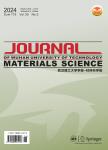Picosecond Laser Machining of Deep Holes in Silicon Infiltrated Silicon Carbide Ceramics
Picosecond Laser Machining of Deep Holes in Silicon Infiltrated Silicon Carbide Ceramics作者机构:Science and Technology on Thermostructure Composite Materials Laboratory Northwestern Polytechnical University State Key Laboratory of Transient Optics and Photonics Xi'an Institute of Optics and Precision Mechanics Chinese Academy of Sciences
出 版 物:《Journal of Wuhan University of Technology(Materials Science)》 (武汉理工大学学报(材料科学英文版))
年 卷 期:2015年第30卷第3期
页 面:437-441页
核心收录:
学科分类:080706[工学-化工过程机械] 08[工学] 0807[工学-动力工程及工程热物理]
基 金:Funded by National Natural Science Foundation of China(Nos.51332004,51302220,51472201) the Major National Scientific Instrument and Equipment Development Project(No.2011YQ12007504) Natural Science Foundation of Shaanxi Province(No.2014JQ6197) the Foundation Research of Northwestern Polytechnical University(No.JC20120204)
主 题:picosecond laser deep holes silicon infiltrated silicon carbide ceramic
摘 要:Silicon infiltrated silicon carbide (Si-SiC) ceramics, as high hardness materials, are difficult to machine, especially drilling micro-holes. In this study, the interaction of picosecond laser pulses (1 ps at 1 030 nm) with Si-SiC ceramics was investigated. Variations of the diameter and depth of circular holes with the growth of the laser energy density were obtained. The results indicate that the increase of machining depth follows a nonlinear relation with the increasing of laser energy density, while the diameter has little change with that. Moreover, it is found that some debris and particles are deposited around and inside the holes and waviness is in the entrance and at walls of the holes after laser processing.



